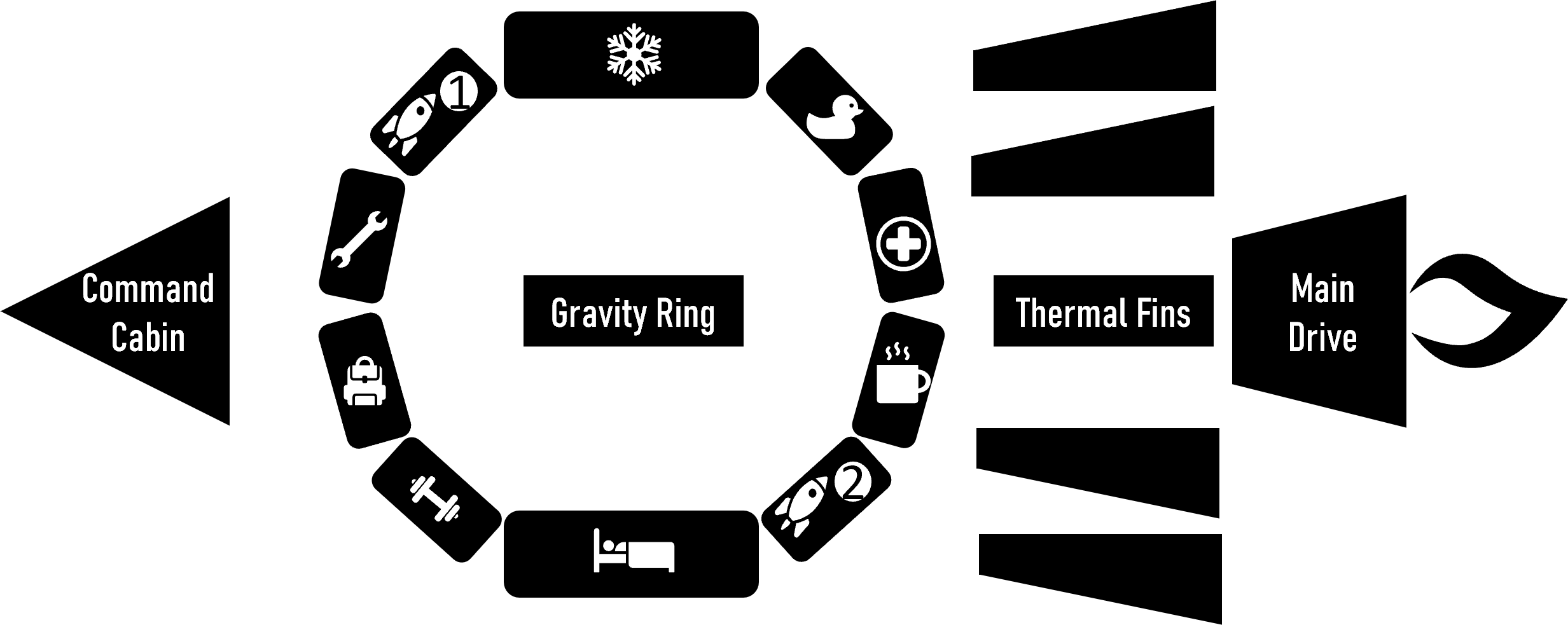A Utilitarian's Dream, A Luxurist's Nightmare
Mass is probably the second-most ignored physical constraint in science fiction right behind distance. It's inconvenient. It's baggage. It holds us in place. According to Einstein, it's the reason why reaching the speed of light is impossible. So I understand why it gets ignored.
But when I set out to design Aspire's mission concept, I wanted to keep one foot in reality. I wanted plausibility. I figured that if I was already down the rabbit hole of making delta-V estimates, I may as well dive all the way in and come up with a dry mass estimate as well.
As usual, if you prefer to see the answer, skip to the table near the end. If you're a massochist like me, buckle up and read on.
The Essentials
Humans are needy creatures and it takes a lot to keep us alive in the cold nothingness of outer space, so let's start there. The abstracted diagram below shows all the essential amenities that Aspire provides its intrepid crew of eight. And I do mean essential. Deep space travel is a utilitarian's dream and a luxurist's nightmare.

Some of this is pretty self-explanatory--the command cabin is the ship's control center; the main drive is a power source and engine to get from point A to point B; the thermal fins are used to reject waste heat from the main drive.
The Gravity Ring is where things get interesting. Starting at the very top of the ring and moving clockwise, we have:
- Cryosleep - to ride out the years of transit in dreamless sleep
- Hygiene - showering and other messy human rituals
- Medical - for when someone inevitably injures themselves
- Mess - eating, drinking, and merrymaking
- Lander Bravo
- Bunk - counting sheep, sleeping, and impromptu tribunals
- Fitness - for maintaining muscle mass during those weeks or months in low/no gravity
- Storage - for all the food stuffs, spare parts, and personal items
- Workbench - 3D printers and tools for when something inevitably breaks
- Lander Alpha
The Guesstimates
That's a lot. And it all costs mass. Not knowing what any of this stuff should weigh, I mostly relied on some real-world comparisons to existing NASA hardware.
I assumed the Command Cabin was the same mass as the Orion Crew Module.
I assumed the thermal fins weighed 12 kg/m2 based on a Wikipedia article.
I sized up a drive used for a theoretical mission to Pluto by a factor of ten.
And for all of the gravity ring elements? Well, here's where things get fuzzy. I calculated a volume for each element. Then I looked to the ISS's Zvezda module and used its mass and volume to arrive at a space module density factor. Since Zvezda has a life support system, plumbing, and electrical, it makes for a reasonable comparison point. But, since Zvezda also includes solar arrays for power generation and a radiators for heat rejection, I reduced the density factor by 20%, since I'm paying for power and thermals elsewhere in my mass budget. I used a density factor of 83.5 kg/m3.
Finally, my ship is missing a structure to tie it all together, so I bumped up the total mass estimate by 20% to account for that.
| Ship Component | Dry Mass |
| Command Cabin | 10,000 kg |
| Thermal Fins | 22,000 kg |
| Main Drive | 14,000 kg |
| Cryosleep + Bunk | 32,000 kg |
| Lander Alpha + Lander Bravo | 21,000 kg |
| Hygiene + Medical + Mess + Fitness + Storage + Workbench | 36,000 kg |
| Structure | 27,000 kg |
| Grand Total | 162,000 kg |
At last, we know how much baggage we're lugging around the solar system! But is this a reasonable estimate? Well, it's ~2x more massive than the Space Shuttle orbiter. It's~3x more than the dry mass of the proposed Deep Space Transport which would carry astronauts to Mars. It's only about 40% of the dry mass of the ISS, which has a lot more internal volume. So, we're probably in the right ballpark.
Armed with this, and our previously derived delta-V estimate, it's finally time to pick an engine.